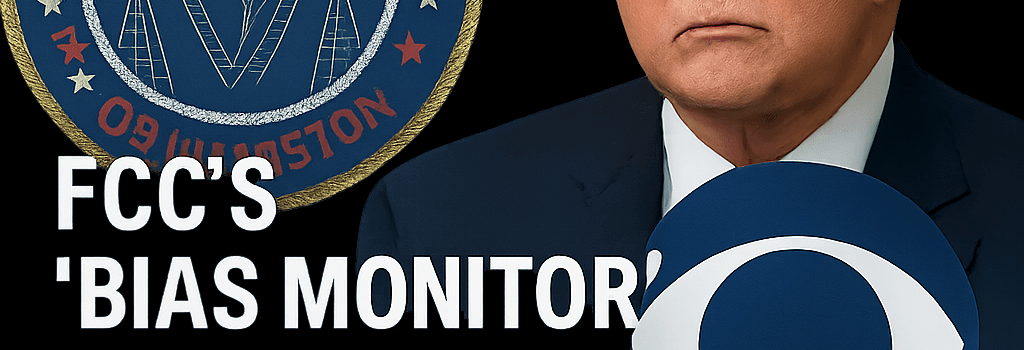FCC’s ‘Bias Monitor’ Requirement for CBS in Trump-Era Merger

Background: Paramount/Skydance Merger Approval
On July 24, 2025, the Federal Communications Commission (FCC) under Chairman Brendan Carr approved the $8 billion merger of Paramount Global and Skydance Media, subject to a novel condition: a two-year “ombudsman” role at CBS News, more baldly described by Carr as a “bias monitor.” This stipulation, unprecedented in its scope, was justified by the Trump-appointed FCC as a mechanism to ensure “fact-based reporting” across CBS platforms and to address alleged editorial slants.
FCC’s Cited Precedent: NBC/GE Ombudsman Case
The approval order footnotes the FCC’s January 2011 consent decree for Comcast’s acquisition of NBCUniversal, wherein General Electric agreed to maintain an ombudsman to safeguard journalistic independence from corporate interests. At the time, the FCC explained:
“Since GE’s acquisition of NBC in 1986, GE has ensured that the content of NBC’s news and public affairs programming is not influenced by the non-media interests of GE. An ombudsman was appointed to further ensure continued journalistic integrity.”
While that conditionality was viewpoint-neutral—focused on preventing business interference—the Trump-era mandate diverges, aiming expressly to monitor potential political bias, particularly against the former President.
Technical Specifications of the Bias Monitoring Mechanism
The order outlines a hybrid compliance framework combining human review with automated analytics. Key components include:
- Ombudsman Office Structure: Reporting directly to Paramount’s president, the ombudsman must assemble a team with expertise in media law, data analytics, and newsroom workflows.
- AI-Assisted Content Analysis: Deployment of natural language processing (NLP) models to perform sentiment analysis and detect shifts in tone. Parameters include entity recognition for public figures, topic modeling for politically sensitive content, and bias scoring calibrated to a dataset of known editorial benchmarks.
- Audit Trail and Logging: Integration of a secure, timestamped logging system that records editorial decisions, segment revisions, and complaint resolutions. The logs must be retained in an immutable ledger (blockchain-style) for potential FCC inspection.
- Quarterly Reporting: Delivery of technical reports, including data visualizations of bias metrics, complaint counts, and response latencies, to both the FCC and a publicly accessible online portal.
Implications for Journalistic Independence
Legal scholars have warned that embedding such oversight could chill editorial decision-making. Professor Laura DeNardis of American University observes:
“Embedding technical compliance tools within a newsroom risks transforming editorial judgment into a policy-enforced metric. Journalists may self-censor to avoid triggering automated ‘bias alerts.’”
Furthermore, the ombudsman’s dual role—as both internal monitor and external FCC liaison—could blur lines between corporate governance and federal regulation, raising novel questions under the First Amendment.
Legal and Constitutional Challenges
Opponents argue the condition constitutes government overreach:
- First Amendment Concerns: Commissioner Anna Gomez (D) decried the mandate as “a direct violation of editorial freedom.” The Supreme Court has repeatedly held that government cannot dictate newsroom content.
- Separation of Powers: Critics assert that the FCC, an independent agency, lacks authority to impose viewpoint-based controls, a power traditionally reserved for Congress.
- Potential Litigation: Multiple media advocacy groups are reportedly preparing lawsuits, citing Miami Herald Publishing Co. v. Tornillo (1974), which struck down government compulsion of editorial speech.
Latest Developments and Congressional Inquiry
Within days of the order, Senate Democrats led by Senator Elizabeth Warren announced an investigation into whether the Skydance-Paramount deal involved improper payments to President Trump. The Department of Justice has also joined the probe, focusing on antitrust and bribery statutes.
Meanwhile, CBS has begun implementing the ombudsman structure. Sources inside Paramount report the company is soliciting proposals from cybersecurity firms to build the secure logging infrastructure, and from AI vendors to refine bias-detection models with precision above 85% F1 score on test corpora.
Expert Opinions: Balance Between Oversight and Autonomy
Media policy expert Andrew Jay Schwartzman notes:
“Ensuring transparency is laudable, but mandating AI-driven oversight risks reducing complex editorial judgments to simplistic metrics. The real question is whether oversight mechanisms preserve the nuance essential to serious journalism.”
Former FCC official Rachelle Chong suggests a middle ground: a non-binding technical advisory panel composed of ethicists, data scientists, and journalists to review the ombudsman’s methods and ensure they align with industry best practices.
Future Outlook
If the bias monitor proves technically robust and legally sustainable, it may set a new template for regulatory oversight of large media mergers. Conversely, successful court challenges could reinforce the boundary between government regulators and editorial autonomy, with lasting implications for media consolidation and digital news governance.
Expanded Regulatory Landscape
- Antitrust scrutiny of streaming platforms and integrated content distributors.
- Increasing use of AI in compliance monitoring across telecom, social media, and broadcasting.
- Potential congressional action to codify or restrict FCC merger-condition authority.
Technical Innovation and Ethical Standards
Moving forward, stakeholders anticipate the emergence of open-source toolkits for bias detection—similar to adversarial fairness libraries in machine learning—that can be audited by third parties. Ethical AI frameworks from organizations like the IEEE and Partnership on AI could inform best practices, balancing transparency with journalistic integrity.
The FCC’s decision marks a watershed in media regulation: a test case for AI-augmented oversight and a flashpoint in the debate over press freedom and government influence.